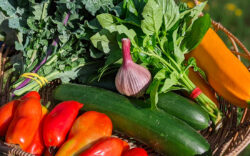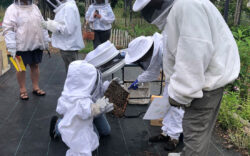The first frost hit, and if you, like me, had a few casualties, it might make you want to put up the gardening gloves for the year. That’s fair. Watching damaged frozen leaves curl and brown can cause despair. Then you add the shortening days, and man, do I get it.
But, if you want to keep growing throughout the colder months, there are a few ways to continue greening up your thumb and reaping the benefits. Here are a few suggestions:
• Bring your tropicals and herbs inside. Folks more qualified than I am can talk a heap about growing plants inside. I just manage to keep the Meyer lemon tree, lime trees and various light-loving tropicals alive (not happy, but alive) during the winter months. My 120-year-old farmhouse has zero windows facing south and likely is as drafty as you can imagine. The second bedroom—which also has the only subflooring in the house—turns into the plant room every winter. The last two years, I’ve kept plants in a homemade pallet-constructed plant bookshelf illuminated by bright fluorescent lights. This year, I’m going to cozy it up, adding plant lights in lamps and focusing one light per plant group.
• Protect your porch from freezing temps with a little help. Twineing Christmas lights (the old-fashioned kind, not the LEDs) around your tender plants can give them enough heat to weather through the winter. Gardeners also use bubble wrap to insulate pots, and thus the roots, of their prized plants. I push my 3-foot olive tree close to the hot tub. Even covered, the hot tub leaks enough heat to keep the frost at bay.
• Frost cloth for garden beds. Quality frost cloth generally protects past 30 degrees Fahrenheit, but not much more than 25 degrees. Just last year, many of my spring veggies got nipped by that 22-degree low in March. Unfortunately, adding another layer of frost cloth does not double its power to keep out the cold. You’ll also need some way to hold the cloth away from wet, tender plants, or else they’ll freeze against the cloth. The cloth also needs pins or sandbags or bricks to secure it in place. I’ve found the best prices and quality on frost cloth online; in person, I’ve seen a lot of over-priced, shoddy-looking products. If you get stuck in a pinch, a bedsheet will work, but not as well as frost cloth. Not every plant needs frost cloth. Right now, my lettuce and bok choy are covered. A month from now, I’ll cover the broccoli and kale. I don’t ever have to cover root crops like carrots, turnips or beets.
• Cold frames for raised beds. A cold frame is like a tiny greenhouse with no heater. Basically, you attach a window to a raised bed on a hinge. This allows fall and winter gardeners to keep harvesting for most of the winter without worrying about heating or blustering about covering and uncovering frost cloth. This is a great way to keep a few low-growing favorites growing throughout the winter, like lettuce.
• A greenhouse. As someone who used to work in a commercial greenhouse, this is something I know and love. Is it a giant pain? Yes. Is it also worth it? Yes, I think so. Greenhouses can grow all sorts of wonderful flora throughout the cold months, and they can be outfitted with heat and lights, tricking plants into growing or blooming when they normally wouldn’t. Some folks get the expensive kits; others make do with whatever they have lying around. Whether you want to start small and cheap or go big and fancy, this tool will up your winter gardening game.
But what if you goofed and now have a frozen plant? Is it just ugly or dead? Some annuals die after one good freeze, like tomatoes or cucumbers. Other annuals, like a sturdy pepper, rely more on the ground’s residual heat and won’t die off until a few frosts in a row. Tropical perennials (many of our indoor plants) should be moved inside as soon as possible, and any damaged leaves should be snipped off. If the plant’s stem feels soggy (that’s from the cell walls bursting while frozen), you’re probably out of luck. Many perennial herbs, like thyme, lose most of their leaves and look terrible, but will bud into beauty next spring. Don’t ditch your unlovely greenery until you know whether it’s an annual or a perennial.
Like what you just read? Support Flagpole by making a donation today. Every dollar you give helps fund our ongoing mission to provide Athens with quality, independent journalism.










